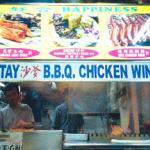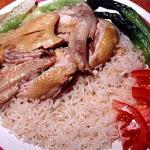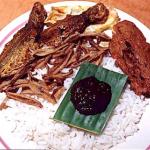Singapore Food
Live to eat, or eat to live? Judging by their love for food and the extent they would travel to even the farthest corner of Singapore (although the island state is a mere 42 km from east to west and 23 km from north to south), it appears that the people in this nation state eat to live.
Shiok. Sedap. Delicious. Three words that connote lip-smacking good stuff. The first, shiok, is a Chinese dialect which expresses that which is darn good and sedap is a Malay word meaning delicious. Westerners are amazed at the amount and varieties of food Singapore has. An American boss of mine once remarked, "I'd recognize you anywhere because you always have food in your mouth." Indeed, yes, eating is our national pastime.
For want of a conversation with Singaporeans, try talking about food. Eyes dance and mouths rave non-stop when it comes to food. These days, e-mails fly with attachments listing yummy food joints. Hawkers enjoy brisk and overwhelming demand as soon as their food is reviewed in the local papers. I know of a local family who makes it a point to check the review in the papers and food-hunting becomes the highlight of their family day.
Singapore, a multi-racial nation of Chinese, Malays, Indians and ethnic minorities, is a food haven. One is never far from a food stall, a coffee shop or a hawker center. Those who live in concrete high rise communities will tell you that they can still get food to satisfy a late night hunger pang even at midnight. In the highly desirable rich districts, restaurants congregate in the fringe of the estates. Shopping centers all have food courts - hawker stalls in air-conditioned comfort. Hotels also fight for a piece of the action and their restaurants employ renowned chefs from all over the world. The food choices in Singapore is a dizzying affair and it is no wonder that at you see kiasu Singaporeans mounting their dining tables. After all, everything looks so nice so must try all, lah. The English equivalent of kiasu, a local dialect, means "scared to lose".
One is spoilt for food choices. Local and international cuisines set up stalls alongside each other. Chinese, Malay, Indian and Peranakan (Straits Chinese) stalls and restaurants rub shoulders with Japanese, American, French, Mexican and Mediterranean counterparts.
Just what is Singapore food? Briefly, it has its origin in Malaysia, Indonesia, China and India. The diversity goes beyond a certain nationality or race. Within a race itself, there are sub-sets. Take Chinese food for example. The gastronomic experience encompasses Teochew, Cantonese, Hokkien, Hainanese and the list goes on.
So what should you try? If you are a Westerner and you are in Singapore, well, do as the Romans do (as the saying goes). Eat what Singaporeans love best. A sampling of our food list would include the following:
* * * * *
Chinese
1. Chicken Rice
Brought to Singapore by the people of Hainan, an island off the southern-coast of China, this is a national dish loved by Singaporeans. Film and singing celebrities in the region, namely from Hongkong and Taiwan, have been reported to have developed cravings for this dish. They visit their favorite joint as soon as they touch down the airport. Chicken rice stalls abound in Singapore. In a hawker center alone, there are not one, but many, chicken rice stalls. Which to choose? Head of course for the one with the longest queue. For an easier bite, look out for stalls that offer boneless chicken where the meat has already been de-boned.
Chicken rice is a complete meal by itself. Ranging from S$3 a plate at hawker centers to more than S$10 a plate in hotels, you get a plate of fragrant rice cooked in chicken stock and pandan (screwpine) leaves. The plate comes with chicken meat and a bowl of clear chicken soup. Be ready to pay a little more if you ask specifically for chicken wings or thighs and innards such as chicken liver and gizzards. The added plus factor is the chilli sauce. Personally, I call this "chilli rice" because I pour generous amount of chilli sauce over my rice and chicken. Hmmmm, sedap.
Where to eat Chicken Rice
Loy Kee Chicken Rice - several branches.
Boon Tong Kee -several branches.
A nondescript stall on the 5th Floor of Far East Plaza in Scotts Road.
Sun Kee on the 2nd Floor of Margaret Drive Food Centre.
Wee Nam Kee at Thomson Road.
Pow Sing Chicken Rice in Serangoon Garden.
Lee Fun Nam Kee located at Block 94, Lorong 4, Toa Payoh.
Chatterbox coffeehouse at the Mandarin Hotel.
Hawker centers and food courts.
2. Seafood
Throw table etiquette out with the wind when it comes to seafood. Seafood comprising crabs done in various styles, prawns and mussels is a finger-licking good affair. So tuck in with your fingers. How do you enjoy succulent crabmeat stuck deep inside its claws if you're using a fork? At some food joints, small hammers are part and parcel of the table setting. These are provided for you to knock the shells off the crabs.
For crabs, order the really big Sri Lankan ones. Have them done in different styles - steam, fried with black pepper or chilli sauce. If you order chilli crabs, be sure to ask for bread to slurp up the delicious sauce. Before the children came, my husband and I used to dine out weekly at Choon Seng Seafood Restaurant (then located in Ponggol) and our delight was in sharing one big pepper crab and one big steamed crab plus a plate of fried mee goreng (fried yellow noodles). We kept at this weekly dinner routine for quite sometime.
Seafood also means drunken prawns - live prawns soak in wine then steam to perfection. Real succulent and fresh. Other popular seafood dishes include fried baby squids and lobsters.
Where to eat seafood
There are many seafood restaurants along East Coast Parkway. Among them are Jumbo and New Kheng Luck Restaurants.
Palm Beach Leisure Park at Stadium Walk in Kallang and West Coast Recreation Centre.
Off the beaten track there is a nondescript stall in Joo Chiat Place that is packed with locals and expatriates. There is another stall at the Jackson Kopi Tiam Food Centre along MacPerson Road. Kopi Tiam is a local dialect which means coffeeshop.
3. Paper Wrapped Chicken
Not another chicken dish, you say. But this one is different. Chicken pieces are marinated with a family-kept secret, then wrapped in paper and baked. The paper wrapped process seals in the original flavours of the marinates, seasonings and the chicken pieces.
Where to eat Paper Wrapped Chicken
Union Farm Eating House at 435A Clementi Road.
4. Prawn Noodles
Noting that this article may reach a sizeable Western group of people, I include this dish for those who want a variety outside of rice meals. Rice incidentally is a staple of Singaporeans.
Oodles of noodles, mostly yellow noodles and vermicelli, topped with kangkong, a vegetable, and prawns are lapped up with a delicious prawn-stock soup. For S$3 a bowl, you get regular size prawns but some stalls have made this an art. They serve fresh and wonderfully big prawns with their noodles. In such circumstance, expect to pay more.
Where to eat Prawn Noodles
Beach Road Prawn Mee Eating House at 370 East Coast Road.
Jalan Sultan Prawn Mee at 2 Jalan Ayer.
Whitley Road Big Prawn Noodle at Block 51 Old Airport Road.
Wah Kee Big Prawn Noodles located at Block 41A Cambridge Market in Owen Road.
Hawker centers and food courts.
5. Steamboat
Fast becoming a norm for reunion dinners when Chinese celebrate the start of their spring lunar year, steamboat restaurants have sprouted at various neighbourhood coffee shops. A much scaled-down version suitable for individuals is available at some food courts. Most of these steamboat joints offer two kinds of soups - a chicken stock-based soup or tom yam, a fiery chilli-hot Thai soup. This is a do-it-yourself meal and is most suitable for group get-togethers. Fresh varieties of fish, vegetables, tofu and noodles are thrown into the boiling pot of soup that is placed over either a charcoal fire or an electric or gas stove. Many restaurants offer this meal buffet-style and charge is based on per person basis. Consume whatever and however much you can eat but there is always a clause at the restaurant to remind eaters not to waste food.
Fish head steamboat is also popular with Chinese Singaporeans. As the name suggests, this is fish head or fish meat slices cooked in a steamboat. The main ingredients consist of fish, vegetables and yam. Nutritious and delicious.
Where to eat steamboat
Coca Steamboat - they have several branches in Singapore.
For individual or small groups of four, try the stall at the basement of Parkway Parade, a shopping centre in the East Coast (the hot tom yam soup here is simply wonderful. Sedap).
Chong Qing Hot Pot on the 4th level of Tanglin Shopping Centre (the varieties of side sauces here give a different experience to the consumption of steamboat).
Hua Yu Wee Restaurant located at 462 Upper East Coast Road.
Where to eat fish head steamboat
Xin Heng Feng Guo Tia Tan located at #01-599, Block 90 Whampoa Drive.
Century Village located at Block 3014 Bedok Industrial Park E (behind Changi Road Fire Station).
Tian Wai Tian Teochew Fishhead Steamboat located at 1382/1383 Serangoon Road (off Opal Crescent).
Chiang's Restaurant located at 366 Geylang Rd.
* * * * *
Malay and Indian Muslims
With many Muslims in the country, halal food is easily available. While chicken rice means much to the Chinese, nasi lemak is the trademark meals for the Malays. Nasi means rice in Malay. Here rice is cooked in rich coconut milk and eaten with fried chicken, fried ikan bilis (anchovies), achar (a kind of seasoned vegetable salad), a fried egg and not forgetting, a dollop of spicy sambal chilli. For Indian rice meals, try nasi padang. Here rice is eaten with a variety of food dishes such as meats and vegetables. Other popular dishes include satay, roti prata, mee goreng, soto ayam, Indian rojak and mutton soup.
Many Malay dishes are done with tasty coconut milk, for example, their wonderful and lemak curries. The vital ingredients in their foods include chillies and sambal belachan (a combination of dried shrimp paste and chillies), spices and herbs like lemon grass, tamarind and coriander.
Don't miss satay, a Malay classic. Chicken, mutton and lamb meats are first seasoned, then string through stick skewers and barbecue over charcoal fire. Satay is served with a spicy sweet peanut sauce, fresh cucumbers, and slice raw onions. Ketupat, an optional with satay meals, is pressed rice wrapped in fragrant pandan (screwpine) leaves.
Where to eat nasi lemak
Ponggol Nasi Lemak at Tampines Road.
International Muslim Food Stall located at #01-57 Changi Village Market & Hawkers' Centre.
Xiang Xiang Cooked Food located at #01-73 Changi Village Market & Hawkers' Centre.
Yusof's Corner located Stall 1, Adam Road Food Centre.
Hawker centers and food courts.
Where to eat satay
Chuan Kee Satay at #01-123S located at 51 Old Airport Road.
Haji Salleh Muslim Food located at #01-123, Block 210 Lorong 8 Toa Payoh Market & Hawker Centre.
Harom located at Stall 30 East Coast Park Lagoon Food Centre.
Suriya located at Stall 28 East Coast Park Lagoon Food Centre.
Shi Xiang Sha Die located at #02-79 in Chinatown Complex, 335 Smith Street.
Hawker centers.
Where to eat Indian rojak (varieties of potatoes, eggs and cuttlefish served with a sauce)
Sajis Indian Food located at Stall 786, 262 Waterloo Street.
Abdul Salam located at #01-73, Ayer Rajah Food Centre.
Hawker centers and food courts.
* * * * *
Indian
Another old time favourite of Singaporeans is Fish Head Curry. The Indians are well known for this dish but there are some Chinese outlets that serve this dish as well. Westerners who are not used to hot chilli spices are best advised to have on standby at their tables loads of fresh lime juice to douse out the heat on the tongues as they tuck in the fiery spicy curry! Some Western colleagues of mine once told me that they felt awful when they noticed the eyes of the cooked fish staring at them over the hot curry. Well, be warned, fish head curry is the name and fish head makes up the main ingredient in the dish. So you get a pretty good size fish head with eyes, mouth and teeth intact. Move the fins away and tuck into the fresh succulent fish meat underneath. Fish head curry comes with popadam, a fried cracker, which can be eaten on its own or dish up the curry with it. Shiok, as a Chinese would say after the meal. In a typical fish head curry stall, rice and salad condiments are served on a piece of banana leaf. Indians eat their meals with their fingers but forks and spoons are provided for those who want them.
Another typical Indian meal is nasi briyani. Here rice is cooked with various spices to which either chicken, fish or mutton is added. The rice, when cooked, turns out to be yellow-orange in colour. A curry gravy is given as an option, and if desired, this could be poured over the rice. Popadam, a fried cracker, is also served with this dish.
Where to eat nasi briyani
Zam Zam Restaurant at 699 North Bridge Road.
A coffee shop at Joo Chiat Place.
Stalls 179 and 182 at Geylang Serai Market & Food Centre.
Hawker centers and food courts.
Tandoori Chicken is chicken marinated for hours with several spices before being baked. Let not the red coloring from the spices deter you from trying this dish because tandoori chicken has superb taste. I know of some expatriates here who love this dish. Tandoori Chicken is most often eaten with yellow rice. Popadam is also given as a side dish.
Another commonly found Indian food in hawker stalls is the roti prata. This is made from flour and the art of making it is a delight to watch. The chef swivels the piece of flour round and round in the air and you wonder why that stuff does not break up. Roti prata comes plain or with eggs or raw onions and is eaten with curry gravy.
Where to eat Fish Head Curry
Muthu's Curry Restaurant in Race Course Road.
Banana Leaf Curry in Race Course Road.
Soon Heng (a Chinese restaurant) in Kinta Road Hawker centers.
Where to eat roti prata
Among the best is Thasevi Food Eating Shop in Jalan Kayu.
To eat in six-star class, try the Empire Café at the Raffles Hotel.
Hawker centers.
* * * * *
 ThingsAsian
ThingsAsian

















